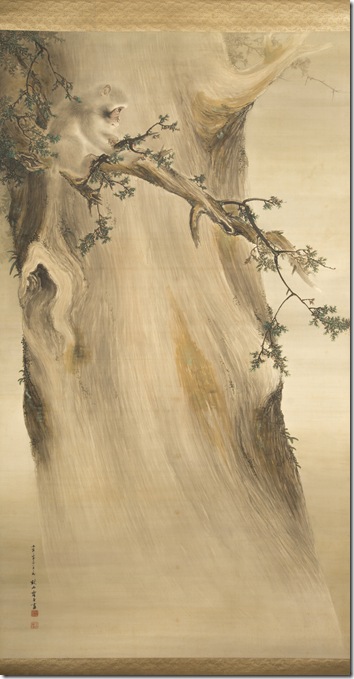If I told you the first hotel run solely by robots just opened and it features a dinosaur concierge, where in the world would you picture it?
It counts if you mention anywhere in Japan — though, technically, it opened in Nagasaki.
The Land of the Rising Sun is also proving to be the most machine-loving, with an invigorating robot culture and a robotic technology that is boundless. Although we wouldn’t necessarily deduce it from Japan’s Robot Kingdom. There are simply not enough robottos in this exhibit housed in the Morikami Museum through Sept. 13. An easy fix is to leave at home our adult expectations and bring our inner child. This is a quality-over-quantity type of show.
The young-at-heart audience is bound to get captivated by funny-looking displays, such as the Robotic Operating Buddy (R.O.B). This was a short-lived Nintendo creation from 1985 that only remained alive through cameo appearances in video games. Its long neck and arms and its big, wide eyes give it an E.T. appearance. That might explain why warming up to it comes easily. The robust Iron Kong PK came two years earlier as part of Tomy’s Zoid biomechanical toy series, which takes after insects, animals and dinosaurs. Bloody Kong — a label its solid red color earned him — is modeled after a bulky gorilla and can deliver a powerful punch with its fist. Its impressive weaponry can protect a whole empire, which is a good thing because there are plenty of enemies. Zoids like him belong to one of two opposing forces: the Helic Republic or the Zebas Empire.
A member of the Republic, Dibison shows the characteristics of a mad bull ready to crush the enemy lines with its sharp metal horns. This 1888 model comes in black and green and we can tell, from the massive canons mounted on its back, it is not a toy to play with but to battle with. We can imagine it as a worthy adversary to Kong.
The I-Sobot, with its boxy torso and claw-like hands, can fool us into thinking height is proportionate to ability. At less than 7 inches tall, this little guy can move its joints freely and perform more than 200 movements, including standing on his head, doing pushups and dancing the Hula. It contains a library of 200 words and phrases and responds to basic voice commands.
As impressive as that sounds, the most remarkable thing displayed is not an object that speaks to Japanese technical ingenuity but to the heart behind it. Paro is a therapeutic robot that provides comfort and relief to patients living with emotional and physical stress. Keeping in mind that negative associations with commonly known animals develop sometimes, Japan came up with a soft and nurturing baby harp seal. The rationale is that our unfamiliarity with this animal aids our acceptance of it. There is no judgment. No preconceived notion gets in the way of the emotional connection.
Paro is the exhibit’s way of highlighting the serious robotic accomplishments already seen in the medical field. With an increasingly aging population that expects the same level of service experienced in its youth, Japan has had to get creative very fast. The sense of urgency, however, has not compromised intention nor made it disregard the human component. In fact, if we had any doubt that this nation continues to master the art of balance (the spiritual with the mechanical, the ancient and the modern) the show’s baby white seal erases it. It proves that sophistication and caring can co-exist.
The one gallery room is successful at awaking a strong appetite for all things robotic but it does not satisfy it. That’s when we should head for The Morikami Menagerie: Creatures in Japanese Art. Running in conjunction with Robot Kingdom, this exhibit explores the spiritual and mythological side of Japan through decorative ceramics, folding screens and scrolls featuring exotic animals and imagined creatures.
Everything here stands for something else. A tiger is a symbol of loyalty and perseverance, even if it is colored bright yellow and made of papier-maché. A hanging scroll featuring a snow monkey in its natural habitat is not just a tranquil portrait of nature but the representation of human strengths and weaknesses. In this case: intelligence and vanity.
Skip the all-too-familiar Lion-Dog hybrids and visit the Tengu Mask on display. This bright-red version depicts the legendary mountain goblins of Japanese folklore that were known to be tricksters and even demonic-looking. It is a surprise to learn that some consider the tengu holy and view them as mountain gods.
Its long nose, small black cap and white hair mimic the appearance of elderly mountain priests who practiced the ancient religion Shugendo. But a softer expression is needed before we can warm up to it.
If the robots and the creatures fail to make an impression, try this before leaving: find the Raccoon-Dog in glazed ceramic. Be sure to read its story. It is a good laugh.
Japan’s Robot Kingdom and The Morikami Menagerie run through Sept. 13 at the Morikami Museum and Japanese Gardens in western Delray Beach. Museum tickets: $15, $13 for seniors, $9 for children and college students. Open 10 am to 5 pm Tuesdays through Sundays. Call 495-0233 or visit www.morikami.org.

